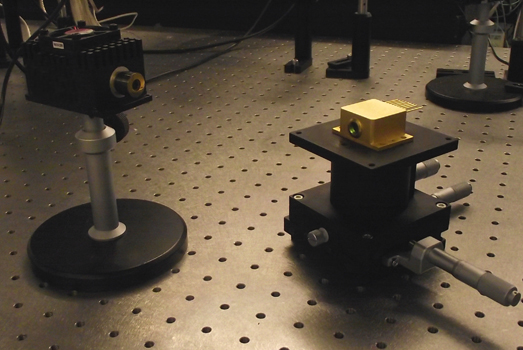'Chirpy' resolution to a shocking problem discovered at KAUST

Post-doctoral fellow Dr. Robin Chrystie (L) and Professor Aamir Farooq (R) exhibit the quantum cascade laser (QCL) in KAUST's Chemical Kinetics and Laser Sensors Laboratory.
Dr. Robin Chrystie, a postdoctoral fellow in Assistant Professor Aamir Farooq's Chemical Kinetics and Laser Sensors Laboratory in KAUST's Clean Combustion Research Center (CCRC), worked on exploiting "chirp," an ultra-rapid scan phenomenon that occurs in semiconductor lasers, to produce a cutting-edge laser-based sensor.
The sensor is able to "surmount past limitations in measuring gas temperature accurately in combustion systems," explained Dr. Chrystie. "We were genuinely shocked to discover that few researchers had exploited the chirping of semiconductor lasers. Chirp has been viewed as a parasitic problem with such lasers, but we decided to pursue the phenomenon to accurately and sensitively measure temperature in combustion systems."
Chirp occurs when step-changes are applied to the input current of the laser. The abrupt change in input to the laser causes the laser to respond, and the color of the light emitted scans through very rapidly, or "chirps." The chirp effect is a transient response to the abrupt input change.
Dr. Chrystie, Prof. Farooq, and KAUST Ph.D. student Ehson Nasir, who also works in the Chemical Kinetics and Laser Sensors Laboratory, were able to resolve and record what occurs while the laser chirps. They used the chirp phenomenon to conduct spectroscopic measurements at very fast rates (1.0 MHz), demonstrating that their simultaneously time-resolved and calibration-free sensor concept could measure temperature at the nanosecond timescale at repetition rates of thousands of kilohertz (kHz). Their results were recently published in Proceedings of the Combustion Institute (DOI: 10.1016/j.proci.2014.06.069).

Dr. Robin Chrystie's cutting-edge laser-based sensor, developed in-house at KAUST, features compact packaging, including a fast photodetector and a quantum cascade laser (QCL).
"For the first time, we were able to measure temperature of the gases in a shock tube with less uncertainty and, at the same time, very rapidly," said Dr. Chrystie. Rapidity is an important aspect, he explained, because shock tube experiments are transient and rapid by nature.
"Temperature measurements are particularly useful to help elucidate chemical kinetic mechanisms in complex multifaceted combustion processes. However, temperature is difficult to measure accurately," Dr. Chrystie continued. "Our sensor benefits from relying on a single laser only, is intuitive, non-invasive, accurate, and is straightforward to implement. The system is rendered possible through the exploitation of chirp in a compact quantum cascade laser, or a QCL, in combination with using ultrafast photodetectors."
The researchers note that establishing insight into the mechanisms of combustion is key to ensuring that energy-intensive technologies – such as engines – function optimally, efficiently, and cleanly. The novel sensor can be applied to systems that exhibit highly time-varying behavior, including internal combustion engines, shock tubes, and gas turbine engines.
"Chirp enables full-spectral measurements to be taken in real time, and renders the ability to monitor temperature without recourse to calibration. This suppresses the uncertainties lurking in traditional approaches," said Prof. Farooq. "Using our invention, researchers in the field of combustion will be better able to measure temperature at rates upward of 1 million times a second, or 1.0 MHz."
Through the exploitation of an originally unwanted phenomenon observed in semiconductor lasers, the researchers have "turned the problem on its head," said Dr. Chrystie, "and demonstrated successfully ultra-fast and calibration-free measurements founded on a simple yet innovative sensor concept employing only a single laser and detector."
By Caitlin Clark, KAUST News

